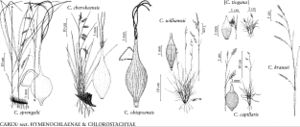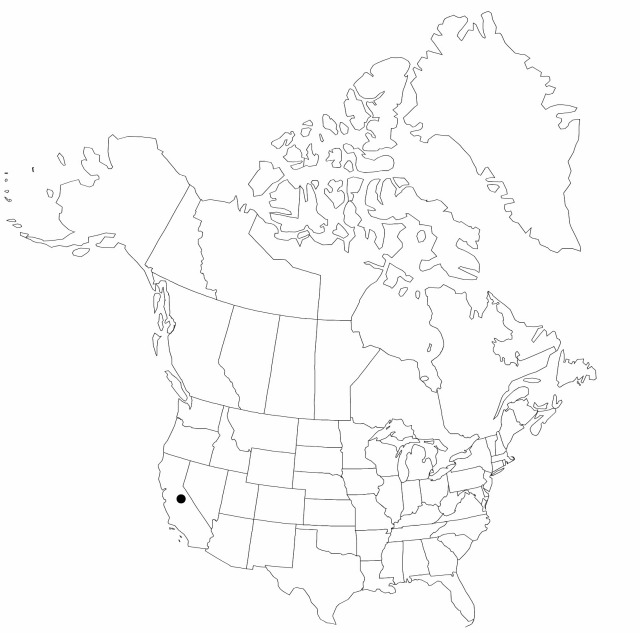Difference between revisions of "Carex obispoensis"
Leafl. W. Bot. 1: 240. 1936.
FNA>Volume Importer |
imported>Volume Importer |
||
| (6 intermediate revisions by 2 users not shown) | |||
| Line 8: | Line 8: | ||
}} | }} | ||
|common_names=San Luis Obispo sedge | |common_names=San Luis Obispo sedge | ||
| + | |special_status={{Treatment/ID/Special_status | ||
| + | |code=F | ||
| + | |label=Illustrated | ||
| + | }}{{Treatment/ID/Special_status | ||
| + | |code=E | ||
| + | |label=Endemic | ||
| + | }}{{Treatment/ID/Special_status | ||
| + | |code=C | ||
| + | |label=Conservation concern | ||
| + | }} | ||
|basionyms= | |basionyms= | ||
|synonyms= | |synonyms= | ||
| Line 25: | Line 35: | ||
|distribution=Calif. | |distribution=Calif. | ||
|discussion=<p>Of conservation concern.</p><!-- | |discussion=<p>Of conservation concern.</p><!-- | ||
| − | --><p>Although Carex obispoensis is rare and endemic to San Luis Obispo County, California, this large, striking sedge has two quite extensive populations in Arroyo de la Cruz and Cuesta Ridge Botanical Area.</p> | + | --><p>Although <i>Carex obispoensis</i> is rare and endemic to San Luis Obispo County, California, this large, striking sedge has two quite extensive populations in Arroyo de la Cruz and Cuesta Ridge Botanical Area.</p> |
|tables= | |tables= | ||
|references= | |references= | ||
| Line 34: | Line 44: | ||
-->{{#Taxon: | -->{{#Taxon: | ||
name=Carex obispoensis | name=Carex obispoensis | ||
| − | |||
|authority=Stacey | |authority=Stacey | ||
|rank=species | |rank=species | ||
| Line 48: | Line 57: | ||
|publication title=Leafl. W. Bot. | |publication title=Leafl. W. Bot. | ||
|publication year=1936 | |publication year=1936 | ||
| − | |special status= | + | |special status=Illustrated;Endemic;Conservation concern |
| − | |source xml=https:// | + | |source xml=https://bitbucket.org/aafc-mbb/fna-data-curation/src/2e0870ddd59836b60bcf96646a41e87ea5a5943a/coarse_grained_fna_xml/V23/V23_870.xml |
|genus=Carex | |genus=Carex | ||
|section=Carex sect. Hymenochlaenae | |section=Carex sect. Hymenochlaenae | ||
Latest revision as of 20:43, 5 November 2020
Plants densely cespitose. Culms dark brown to chestnut at base, surrounded by remains of previous year’s leaf bases, but not conspicuously fibrillose; flowering stems 60–180 cm × 2–2.5 mm, much longer than leaves at maturity, glabrous. Leaves: sheaths glabrous, ivory to brown on back, dark chestnut-hyaline on front, sometimes finely red dotted near apex; blades rigid, flat distally but often keeled or channeled near base, margins revolute, 4–8 mm wide, finely retrorse-scabrous adaxially, margins and abaxial midribs also sometimes finely scabrous. Inflorescences: peduncles of lateral spikes slender, to 10 mm, finely scabrous; peduncle of terminal spike scabrous; proximal bracts shorter than inflorescences; sheaths 9–100 mm; blades 2–3.5 mm wide. Lateral spikes 6–15, 1–3 per node; proximal spikes well separated (except those at same node), erect or arching at maturity, pistillate with 15–45 perigynia attached less than 1 mm apart, cylindric, 2.5–8 × 4–6 mm; distal spikes staminate or androgynous, erect, crowded near apex, sessile or short-pedunculate. Terminal spike staminate, often crowded with other staminate or predominantly lateral staminate spikes, 20–80 × 2.5–7 mm. Pistillate scales suffused with chestnut except for hyaline margins and green midrib, ovate to oblong, shorter than mature perigynia, apex acute, sometimes with scabrous awn to 1 mm, glabrous. Perigynia green, usually red dotted, strongly 2-ribbed, 12–20-veined, loosely enveloping achene, lance-ellipsoid, 5–8 × 1.4–2.7 mm, membranous, base with short stipe, apex tapering to beak, shortly and evenly pubescent; beak bidentate, margins serrulate. Achenes sessile, 3–4 × 1.4–2.2 mm.
Phenology: Fruiting spring–early summer.
Habitat: Springs or seeps in chapparal
Elevation: elevations below 600 m
Discussion
Of conservation concern.
Although Carex obispoensis is rare and endemic to San Luis Obispo County, California, this large, striking sedge has two quite extensive populations in Arroyo de la Cruz and Cuesta Ridge Botanical Area.
Selected References
None.

